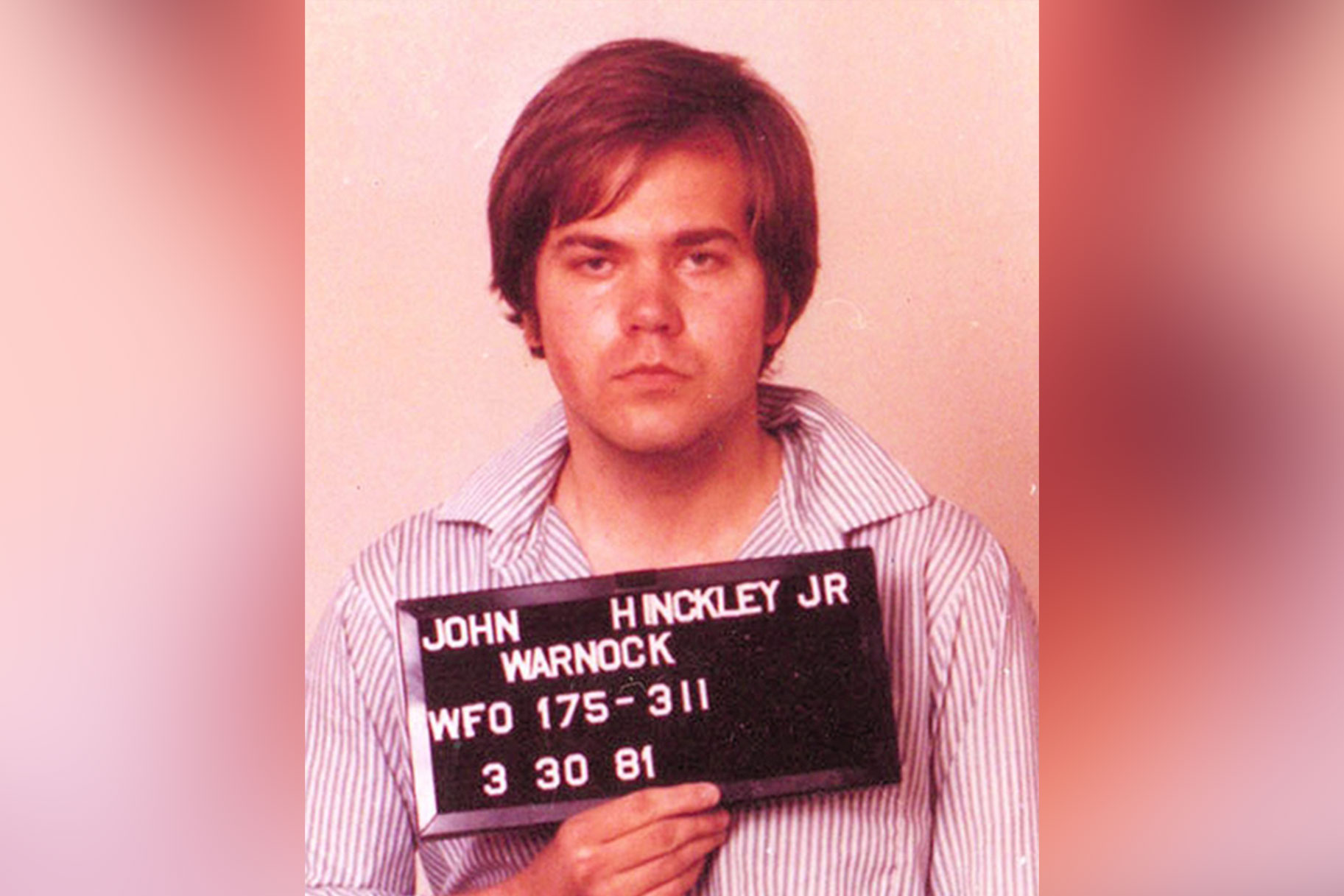Create a free profile to get unlimited access to exclusive videos, breaking news, sweepstakes, and more!
An Attempted Assassination, Celebrity Obsession, And Serial Killer Pen Pal: Who Is John Hinckley Jr.?
John Hinckley Jr. was just 25 years old when he stood outside a Washington D.C. hotel and opened fire on Ronald Reagan on March 30, 1981, striking the president and three others in a hail of bullets.

John Hinckley Jr. was just 25 years old when he stood outside a Washington D.C. hotel with a group of reporters and spectators, waiting for then-President Ronald Reagan.
When the president emerged from a Washington D.C. hotel after giving a speech and waved to those milling about, Hinckley Jr. opened fire, striking Reagan in the chest as he dove into a bulletproof car and wounding three others in a hail of gunfire.
“It sounded like firecrackers, you knew in an instant it couldn’t be firecrackers. You then assumed it was a gun,” reporter Judy Woodruff, who had been a member of the press pool at the time, told “Dateline: Secrets Uncovered," airing Wednesdays at 8/7c on Oxygen.
Reagan was rushed to a local hospital, where he underwent emergency surgery, as Hinckley Jr. was quickly apprehended by members of the Washington D.C. police.
“He looked like a college student,” retired homicide Detective Eddie Myers recalled. “He just didn’t seem to fit the profile of what I thought a presidential assassin would be like.”
The brazen assassination attempt secured Hinckley Jr.’s place in the history books, but it would be his bizarre reason why he tried to kill the president, the stunning conclusion to his trial, and his unlikely serial killer pen pal that would continue to captivate the public for years to come.
Hinckley Jr. had left a handwritten note penned to Hollywood actress Jodie Foster in his Washington D.C. hotel room.
“There is a definite possibility that I will be killed in my attempt to get to Reagan,” the letter began. “It is the very reason that I am writing you this letter now.”
The letter went on to reveal that he had attempted to kill the president to get Foster’s attention.
“He explained he was doing this great act of love to impress her and win her heart,” retired FBI agent Thomas Baker told reporter Troy Roberts.
Investigators would soon learn that Hinckley Jr. had been stalking Foster for months while she was a student at Yale University, slipping love notes under her door and calling her phone.
“Jodie, Goodbye! I love you six trillion times. Don’t you maybe like me just a little bit? (You must admit I am different) It would make all of this worthwhile,” one note read, according to “Dateline: Secrets Uncovered.”
Los Angeles Times reporter Del Wilber, who also wrote the book “Rawhide Down” about the assassination attempt, said Hinckley Jr.’s obsession began in 1976 when he watched the movie “Taxi Driver” more than a dozen times. Foster played a young prostitute in the movie who befriends a disturbed taxi driver named Travis Bickle, portrayed in the film by Robert DeNiro, who begins to plot his own assassination of a presidential candidate.
“He completely identified with Bickle. He thought that he was going to shoot Reagan and die in a hail of Secret Service bullets just like Bickle thought he would,” Wilber said.
However, Hinckley Jr. was taken into custody alive.
His attorneys set out to use his bizarre obsession with the actress as proof that he was not sane at the time of the shooting.
At the time, the burden of proof lay with prosecutors, who would have to convince a jury that Hinckley Jr. — a man who had grown up in Colorado with a family, according to his friends, that was much like the idyllic family in “Leave It To Beaver” — was sane during the March 30, 1981 assassination attempt.
“He told me that his goal was to be on the cover of Time Magazine,” Dr. Park Dietz told “Dateline: Secrets Uncovered.”
Dietz served as a lead psychiatrist for the prosecution, arguing that Hinckley Jr. had been aware his actions were wrong and would harm others when he pulled the trigger that day.
The defense team relied on testimony from psychiatrist Dr. William Carpenter, who had diagnosed Hinckley Jr. with schizophrenia and argued that Hinckley’s judgement had been impaired by his delusions.
“He developed this grandiose view of Jodie and him as a couple,” Carpenter told “Dateline: Secrets Uncovered.” “He felt this is something everybody should know about.”
As both sides battled it out in court during a seven-week trial, Hinckley expressed his own thoughts in a diary he kept in jail.
“There are many times when I thoroughly regret the incident and then many times when I think about what I’ve accomplished and feel satisfied,” he wrote in one entry.
The jury would ultimately determine that Hinckley Jr. was not guilty by reason of insanity.
“I was shocked. We could not wrap our heads around how a jury could get it so wrong,” Dietz said.
RELATED: Was The Right Man Convicted In The 1994 Disappearance Of A Teen Gas Station Clerk?
Hinckley Jr. was sent to St. Elizabeth’s hospital in Washington D.C. to receive an intense regimen of counseling and medication with anti-psychotic drugs.
While at the psychiatric hospital, Hinckley Jr. began a romantic relationship with fellow patient Leslie deVeau, who had been sent to the hospital after killing her own 10-year-old daughter.
The pair left secret notes for each other in the cafeteria, talked by Hinckley Jr.’s window, and spoke at chaperoned events before eventually getting engaged.
While writer Elsa Walsh, who interviewed deVeau about the relationship for The New Yorker, said hospital officials saw the relationship as “healthy growth,” Hinckley Jr. had also been cultivating a much darker relationship.
Hinckley Jr. began writing serial killer Ted Bundy, who was on death row in Florida at the time awaiting his execution.
“Dear John, I think we’ve got something going here, John,” Bundy wrote in one letter. “It’s always a pleasure to find someone I feel comfortable writing.”
The Secret Service would later learn that the two men had been writing each other for months.
“Dear Ted, I read about your new death order,” Hinckley Jr. wrote his budding pen pal. “It really upsets me, because I’m against the death penalty and I value you as a friend.”
Hinckley Jr. also still seemed to be pining for his celebrity obsession and was found with 20 photos of Foster in his room.
Hinckley Jr. remained at the psychiatric hospital for decades, but in the early 2000s he began to spend time outside of the hospital on day trips before a judge determined he’d be allowed to spend time with his parents at their upscale gated community in Williamsburg, Virginia overlooking the 13th hole of the Kingsmill Resort golf course.
Not everyone agreed that Hinckley Jr. deserved the growing freedoms.
“In the past few years who’s played on that tee is people like President Barack Obama, former President Clinton, I mean these are the people who play golf at Williamsburg and this fellow is only 50 feet away,” Baker said.
In 2016, St. Elizabeth’s permanently released Hinckley Jr. — whose relationship with deVeau had ended by then — although he was forced to follow court rules like going to therapy, taking his medication, limiting his travel, and having no contact with Foster or the families of his victims.
“He volunteers at a church, goes on walks,” Wilber said of his life today. “He’s established a bunch of friends over time.”
He was fully released from psychiatric care and the court restrictions in June of this year.
Hinckley recently spoke to Piers Morgan on “Piers Morgan Uncensored” to discuss his life and the sensational crime, according to Fox News.
Morgan asked him whether he felt he was responsible for the death of Reagan’s press secretary John Brady, who was paralyzed after being shot in the head during the assassination attempt. He died decades later in 2014 in what the coroner ultimately ruled a homicide.
“Do you accept now that because you fired the gun at James Brady that caused catastrophic injuries and subsequent death, that you were guilty of his murder?" Morgan asked.
"Well, I wouldn’t say that. I mean, I certainly caused him to have devastating injuries but I believe he lived on for another 30-something years," Hinckley said. "So I can’t really say I’m the cause of the murder."
When pressed, however, Hinckley Jr. said he would “say yes” that he ultimately killed him.
Hinckley told Morgan that he believed his release after 35 years of treatment was “very justified.”






























